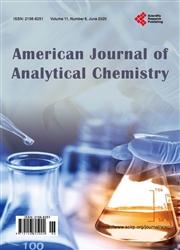Spectroscopic Sensing Characteristics of Novel Osmium Carbonyl Complexes to DNA and Other Polyanions
引用次数: 0
Abstract
In this research, the absorbance and luminescence response of two osmium(II) phenathrane (phen) carbonyl complexes to various DNA, heparin and i-carrageenan polyanions were studied. The [Os(phen)2CO(L)]2+ complexes with L either a 4-phenyl pyridine (4-phpy) or phenyl imidazole (phimd) group exhibit moderate luminescent intensity in the visible region, their intensities are highly altered by the addition of DNA and other polyanion samples. These luminescent responses to polyanions were also compared with the [Ru(phen)3]2+ complex. In ethanol solution, the presence of polyanions significantly enhanced the luminescent emission intensity of [Os(phen)2CO(L)]2+ complexes with a blue shift. While the polyanions all showed emission enhancement on the highly lumi-nescent [Ru(phen)3]2+ complex in ethanol solution with a red spectra shift. The [Os(phen)2CO(L)] 2+ with (phimd) ligand has the lowest emission in ethanol solution, its intensity can be enhanced up to 11 times in the presence of DNA polyanions. This enhancement for all the complexes in ethanol is mainly due to their electrostatic interaction with the anion sites and with some degree of ligand intercalation into the polyanion hydrophobic structure which reduced the solvent quenching of the complexes. The blue shift of the (4-phpy) and particularly (phimd) Os(II)CO complexes indicate an insertion of the (4-phpy) or (phimd) group into the polymer chains. The two new Os(II)CO complexes has great potential to be used as luminescence sensors for DNA and polyanion detection in the low micro molar range with high sensitivity.新型锇羰基配合物对DNA和其他聚阴离子的光谱传感特性
在本研究中,研究了两种锇(II)菲萘(phen)羰基配合物对不同DNA、肝素和i-卡拉胶多阴离子的吸光度和发光响应。含有4-苯基吡啶(4-phpy)或苯基咪唑(phimd)的[Os(phen)2CO(L)]2+配合物在可见光区表现出中等的发光强度,其强度受DNA和其他聚阴离子样品的加入而有很大的改变。这些发光响应也与[Ru(phen)3]2+配合物进行了比较。在乙醇溶液中,多阴离子的存在显著增强了[Os(phen)2CO(L)]2+配合物的发光强度,并伴有蓝移。而聚阴离子对乙醇溶液中高荧光[Ru(phen)3]2+配合物均表现出发射增强,并伴有红光谱偏移。具有(phimd)配体的[Os(phen)2CO(L)] 2+在乙醇溶液中的发光强度最低,在DNA多阴离子存在下,发光强度可提高11倍。乙醇中所有配合物的这种增强主要是由于它们与阴离子位点的静电相互作用和一定程度的配体插入到聚阴离子疏水结构中,从而降低了配合物的溶剂猝灭性。(4-phpy)特别是(phimd) Os(II)CO配合物的蓝移表明(4-phpy)或(phimd)基团插入到聚合物链中。这两种新的Os(II)CO配合物在低微摩尔范围内具有很高的灵敏度,可作为DNA和聚阴离子检测的发光传感器。
本文章由计算机程序翻译,如有差异,请以英文原文为准。
求助全文
约1分钟内获得全文
求助全文

 求助内容:
求助内容: 应助结果提醒方式:
应助结果提醒方式:


